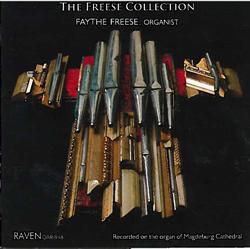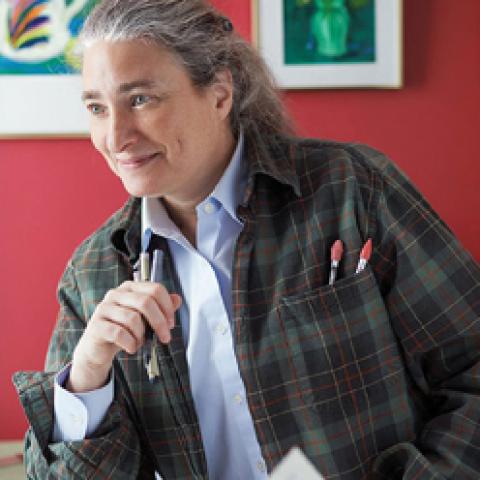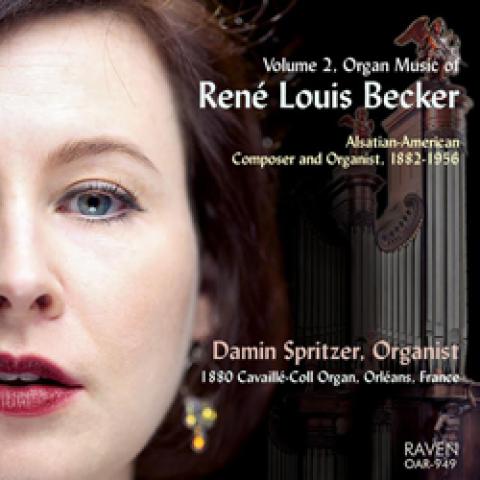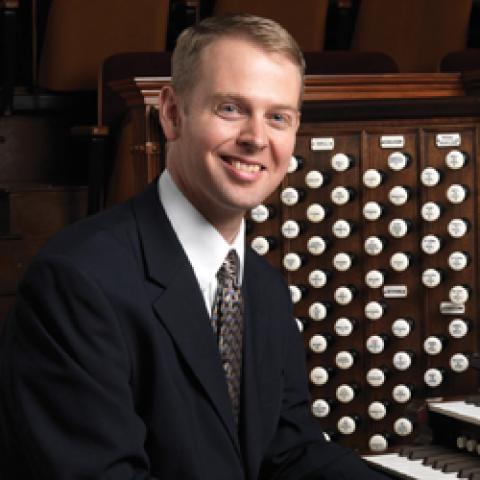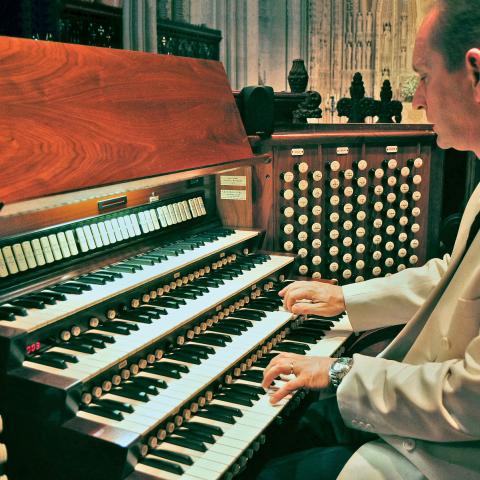Old age for most people means a slowing down and a loss of the abilities they once had. If they are among the few who live to their ninth decade, they usually live a very limited existence.
If they are among the very few, often very gifted, artists who are sustained by their art and who, by force of will, work at their art, they continue to be productive in their chosen field. One thinks of the painter Andrew Wyeth who remained active in his work until he died, and was nourished by his deep roots in Pennsylvania and rural coastal Maine. As a young man, after determining what he was about, he remained true to his calling throughout his life, undeterred by different trends that swirled around him.
Heinz Wunderlich has also been sustained by his roots, which reach back to the music of Max Reger, transmitted to him by his teacher Karl Straube. And, like Wyeth, Professor Wunderlich has remained true to his calling, digging deep into the music of Reger and Bach and carrying that tradition into the 21st century with his own works, despite trends that have gone off in all directions.
Hamburg celebrations in 2009
On April 25, 2009, Heinz Wunderlich will turn 90. As happens every five years for Wunderlich’s birthday, all Hamburg turns out for a festival of recitals. This year is no different.
The first concert is to be at St. Petri on Saturday, April 25, and is an organ recital of Wunderlich’s works played by former students: Dörte Maria Packeiser (Heidenheim), Eva-Maris Sachs (Erlangen), Sirka Schwartz-Uppendieck (Fürth), Izumi Ikeda (Japan), Jay Zoller (USA), and Andreas Rondthaler (Hamburg).
Sunday morning, April 26, Wunderlich’s Ökumenische Messe (2006) under the direction of former student and Director of Music at St. Petri, Thomas Dahl, will receive its premiere. On Tuesday, April 28, Heinz Wunderlich will play a recital at Hauptkirche St. Jacobi where the famous Arp Schnitger organ resides. Wednesday the 29th, back at St. Petri, there will be a concert for chorus, organ, and orchestra that will include the Concerto for Organ and Orchestra on the name of BACH by Heinz Wunderlich. The generous acoustics of both St. Petri and St. Jacobi and the high caliber of the artists involved will make each of these concerts an event to remember.
I have always come away from these concerts in the past with a feeling for the great respect and love that Professor Wunderlich’s former students and his Hamburg audiences have for him. His late wife, the violinist Nelly Söregi-Wunderlich, once told me that when he plays in Hamburg the church is always full. I have found that to be true in the concerts I have attended.
At 90, Heinz Wunderlich continues to compose, play concerts, and prepare his earlier compositions for publication. Retirement for him has only meant a change of emphasis from teaching and church work to writing, recording,
and publishing.
Early life
Paul Arthur Heinz Wunderlich was born in Leipzig on April 25, 1919. At the time of his birth, the First World War had just ended and the Paris Peace Conference was meeting to decide the fate of Europe. Indeed, the Treaty of Versailles was signed a mere two months after his birth. The social upheavals that occurred during the next twenty years before World War II did not radically interrupt his childhood, which was very quiet. However, inflation worsened and by 1929 had affected the whole world economy. There was fear and uncertainty as Hitler made his bid for power. In May 1936, the 17-year-old Wunderlich witnessed the destruction of the Mendelssohn Memorial in front of the Gewandhaus and the loss of jobs that many musicians suffered.
As a young child of five, Wunderlich was traveling on the train with his parents when a faulty door latch let the child fall out of the moving train onto the tracks between two moving trains. His father pulled the brake to stop the train and a doctor who happened to be on board administered to the child until they reached the hospital in Leipzig. The train company was found negligent and made monthly payments to the family.
Wunderlich’s family was musical. On his father’s side were pianists, all the way back to his great-grandfather.
I began taking piano lessons from my father when I was ten. I made progress and one year later began studying piano and composition with Joachim Voigt who was the organist at our church. I grew interested in the organ, and when I was fifteen began studying organ with Mr. Voigt as well. I studied the flute for awhile and, for a little time, the violin also, but I cannot play either now.
My father wanted to study piano at the Hochschule, but couldn’t because he had no money for that. His father was a piano teacher and his father, my great-grandfather, as well as his father, my great, great-grandfather, were all piano teachers. I also had an uncle who was a very good cellist, but he died very young.2
On his mother’s side of the family were musicians also.
My mother played the piano a little bit. She played some with me. My mother’s cousin was a conductor in Prague and my grand aunt from the same family as my mother was a singer. She sang in opera and also got her start in Leipzig.
Musical training
At the age of sixteen, Heinz was accepted into the Academy of Music in Leipzig, earning the distinction of being the youngest student at the famous school. It was there that he began organ study with Karl Straube, who had been a friend and colleague of Max Reger. At sixteen he began his study of and lifelong interest in the music of Max Reger.
We were three, four, five students in one four-hour class with Straube. And so we listened to all of the other students as they played and I played too. We played chorales, preludes, music of Bach, the music of Franck, French music, and also Reger. It was at this time that I began studying Reger. It was required of us. Reger had been a teacher in Leipzig and all of the great organists had come to Leipzig to study with Straube and before with Reger. Reger had been the older generation. He died in 1916 before I was born. But, Reger was required study and his compositions were very important.
Wunderlich also began his study of composition and choral conducting with Johann Nepomuk David. The rigorous training he got from this famous composer has stayed with him.
David was a very famous composer. In my last year, I had to write fugues based on the fugues from the Art of Fugue by Bach. They are complicated fugues with their own themes and we had to write our own themes and double and triple fugues. We began our study with fugues of Palestrina and studied all the old techniques and later on we came to modern music. It was very thorough.
When I asked Wunderlich if he remembered his very first compositions he said, smiling, “Yes, it was before this time, when I was 14 or 15 years old. But, I lost them!”
Another part of his musical training was orchestral conducting with Max Hochkofler. Hochkofler was Germany’s most famous conductor at the time and had many students.
In 1937, at the age of 18, Heinz accepted his first organist position, becoming the second organist at the Petri Church in Leipzig. The organist of this church was the second director of the Music Academy. It was great experience for the young man because he played services and pieces with orchestra. It was during this time, in 1938, that he wrote the Kontrapunktische Chaconne g-Moll.
Wunderlich completed his music degree in 1940, but continued to study with Straube through 1941. His examination was the finest testimonial earned up to that time at the academy: “with distinction in masterly organ performance and improvisation.” It was during these student days that he became widely known, not only for his many recitals, but also as an improviser. Wunderlich was the first student that Straube ever let play the Reger Phantasy, op. 57, in public.
Military service
After his additional year of study with Straube he was appointed Church Music Director at the Moritzkirche in Halle in 1941, a position once held by Samuel Scheidt. The German army drafted him, however, and his job had to wait. It was not a desirable time to be enlisted in the army, but because he had had typhoid as a child, he had problems with his heart. So, he was only fit for home duty. The military was also stationed in Halle and so in the evenings when the other soldiers went to drink beer, he could go to church and practice. He was discharged from the military in 1943.
During his time in the military, though, he studied with Heinrich Fleischer, a good organ teacher, who had also been a student of Straube. Wunderlich wrote the Fuga Variata in 1942 while he was a soldier.
Civilian life in East Germany
Upon completion of his military duties in 1943, Wunderlich began teaching organ and harpsichord at the Church Music School in Halle. It was here at his church where bombs fell just ten days before the end of the war. He was hiding in a basement with some other people, and after one of the bombs exploded on the other side of the wall, they were fortunate to be able to escape through the rubble. When they emerged, everything had been destroyed.
A week after the war ended, Wunderlich played a recital in his church, which had apparently been spared. Since there were no newspapers, they had to put up small handwritten notices. At the recital there were 1,000 people crowded into the church, many of whom could not sit down. It was a very emotional experience for all of them.
The Americans were in Halle until August of 1946, and then, because of Potsdam, it was given to the Russians. An American captain who had attended the recital in Halle later arranged a recital in Washington, D.C. in 1962 or ’63. That same captain was by then a professor of music history in Washington.
In 1946 a drunk Russian soldier stuck his pistol in Wunderlich’s face and demanded his papers, which he then said were forged. Wunderlich was ordered to accompany him, and they met yet another drunken soldier. Fortunately for Wunderlich, a Russian officer happened to see them and ordered the soldiers to go with him. Heinz was able, then, to make his escape.
Wunderlich met his first wife, Charlotte, in about 1943 while he was in Halle, and they married in 1946. It was for her that the Partita on “Macht hoch die Tür” was written in honor of their first Christmas together. They had twin daughters, Uta and Christina, born in 1949, and a third daughter, Ulrike, born in 1951.
In 1948 he wrote the Mixolydische Toccata and, just two years later, for the 200th anniversary of the death of Bach, played the complete organ works of Bach in a series of twenty-one concerts. It was also at this time that he became Overseer of Sacred Music and Organ for churches in the area.
There were 150 churches and I had to teach the organists, some of whom were not very advanced; many were not proficient at all. The organs were in need of repair after the war and I advised on what the organs needed by way of repairs and maintenance. Some needed pipes, it included almost anything. It was interesting.
Escape from East Germany
Wunderlich remained in Halle until 1958. One aspect of life under the communist government was that his career could not advance as rapidly as that of his contemporaries in other countries. He had received a number of offers to teach in the West, but as a church musician he was regarded as an enemy of the state. Although he had played concerts in the West including some at St. Jacobi in Hamburg, he could not get permission to leave the East and would have to do so illegally. The officials in Hamburg had expressed an interest in him, but without permission he could not leave. It was a difficult time for his young family. He had three young daughters, two who were nine and one who was seven. They had to go through Berlin before the wall was put up, and although you could go from east to west all the time, to avoid suspicion they could not travel together. So, Heinz went first; his wife and children came on a later train. Then, they met in West Germany much to the relief of all.
Heinz had sent his music and his books all out of the East the previous year to many different people in the West for safekeeping. And in that way, he was able to save much of the more important things. However, he had an organ and a piano in Halle that had to be left behind.
Professional life in the West
I had the possibility of two positions, one in Dortmund and one in Hamburg. We went first to friends in Dortmund, but after a week I thought, no, this is not the right place for me. It was an academy of music, but I had no organ to practice so it was a problem for me. So then, we went to Hamburg where there were organs and one month later I was the organist at St. Jacobi. They had wanted me to come a half year before since my recital there, but it couldn’t be done any faster.
St. Jacobi is the home of the 1694 Arp Schnitger organ, which was to become famous during succeeding decades. It had been saved from destruction in the Allied bombing of Hamburg by the foresight of church officials who removed the pipes and mechanisms to a safe location.
It was at this time that I met Mr. Howes: Arthur Howes, from Baltimore. I played a recital when he died. He came with the American organbuilder, Charles Fisk, who had built an organ in Baltimore. I showed them all the organs in Hamburg. Mr. Fisk was interested in the pipes and examined them carefully. A year later they invited me to play in America. My first performance was in Baltimore on the new organ and then Mr. Howes arranged for me to play at the Methuen Memorial Music Hall in Methuen, Massachusetts. A year later I came back and did a master class in Andover.
Heinz Wunderlich’s schedule was very busy once he began playing at St. Jacobi. By necessity, he played an important part in overseeing the restoration of the large four-manual Schnitger organ. He established the Kantorei St. Jacobi, a 100-member mixed chorus that sang at services and gave concerts. They had an extensive repertoire ranging from Bach and Mendelssohn to Stravinsky. The choir made several tours under Wunderlich’s direction, including one to the United States in the fall of 1978. Concurrently with the St. Jacobi position, Wunderlich was also Professor of Organ and Improvisation at the College of Music in Hamburg. Wunderlich did much promotional work for the important St. Jacobi organ as well. His recitals devoted to cycles of works by Bach and North German composers; his summer “Schnitgerfest,” a summer series of recitals; his authoring a book about the organ; and hosting the endless stream of visitors to the organ loft, all helped to underscore the importance of the organ.
Max Reger
In the years between 1960 and 1970, Wunderlich oversaw the building of another organ for St. Jacobi that would be ideally suited for 20th-century music and particularly the music of Max Reger. Wunderlich studied the music of Reger with a close friend of Reger, Karl Straube, and as a result is one of the few organists in the world today who is in a direct line of succession with Reger. Reger has remained one of Wunderlich’s passions—performing Reger’s music and writing about him (see The American Organist, March 2002). The year 1973 brought the centenary of Reger’s birth, and during three days of a Reger festival at St. Jacobi, Wunderlich performed all of the large compositions, taught a master class, and directed a festival service. I asked Professor Wunderlich if he played all of Reger’s works.
No, no. He wrote more music than Bach. Look, I have all the works of Reger. [He goes over to a long bookshelf and takes about half the books off one shelf.] His early pieces look easy, but they get more difficult. He also has many unimportant works so you have to see what is important.
With Reger’s pieces there are many problems; there are things which cause misunderstandings. For example, his Allegro should be much slower than an Allegro for other composers. Reger himself says “Don’t play my pieces too fast. The tempos we wrote down are much too fast; play everything quite steadily, even if faster is indicated!”
It is also necessary in Reger that you hear everything. You have to hear every change; that is important. Sometimes the changes occur every 16th note and if it is played too fast, it becomes confusing.
The early years at St. Jacobi were very busy years, and by Wunderlich’s own admission he was unable to compose much:
From 1957 to about 1980 I was very busy with my choir and I played all over the world and I simply did not have time for composition; it was impossible to write pieces. After that, I did not have a choir and, although I taught at the Hochschule, I had more time to compose.
In 1982, Wunderlich lost his wife, Charlotte, to cancer. It was also in that year that he decided to resign his post at St. Jacobi, although he continued to teach at the Hochschule. Wunderlich’s large-scale organ work, Hiroshima, dates from 1978 and is based on a theme given him by György Ligeti. Ligeti, also a professor at Hamburg’s School of Music, would often give Wunderlich themes for his improvisations. This piece is based on one of those themes.
Marriage to Nelly
The two decades following 1982 were productive ones for Wunderlich. He married Nelly Söregi, a violin professor at the School of Music, in November of 1984. Thus began a professional musical relationship that was to span two decades, until Nelly’s untimely death in January of 2004. Nelly was born in Budapest, Hungary and fled to Austria in 1945. Later she was to move to Hamburg, where she taught violin at the Hochschule. Nelly was a concert violinist of international stature, and she and Heinz concertized extensively throughout the world, and also made a number of recordings together. They can be credited with creating an awareness of the organ/violin sonatas of Rheinberger and Kodály.
Compositions
In 1988, Wunderlich wrote the Introduction and Toccata on BACH. In the 1990s there followed Dona nobis pacem, Sonata on Jona, Variationa Twelvetonata (violin and organ), and Emotion and Fugue. The Dona nobis pacem was written for the 1000th anniversary of St. Wolfgang.
The piece commemorated 1000 years after the death of St. Wolfgang. In Germany, he was a famous bishop who worked for freedom for Germany, Czechoslovakia, and Hungary in a bad time of war. I wrote the piece for the Community of St. Wolfgang in Austria.
The original version was written for violin and organ, but Wunderlich also wrote a version for organ solo.
One very interesting piece, a monumental work dating from 1996, is the Sonata über den Psalm Jona. Unlike many of the earlier pieces that are developed around a particular musical form, Jona is a programmatic work dealing with the separation that was Jonah’s when he fled from God. The piece even includes in its preface the plea from Jonah as he lay in the belly of the whale. The piece is terrifying in its impact. However, when I discussed it with Professor Wunderlich, he had this to say,
It is not about a fish! You are born, how would you say, reborn. You are in death and you are reborn anew. It is the story of Christ; the story of Easter.
Concerts and teaching
Heinz Wunderlich is a concert organist of international stature. He has played concerts in virtually every civilized country in the world, including 23 tours in the United States alone. In more recent years he has concertized extensively in former Eastern bloc countries. He has also performed for radio, television, and film. His list of CDs is extensive. As a result, Wunderlich’s name has attracted organ students from all over the world, and that list reads like a Who’s Who in the organ world. Without exception, former organ students found him to be patient and kind and sensitive to their needs. A former American organ student, Nancy Boch-Brzezinski, had a typical response:
I enjoyed him as a teacher because of his musicality. Nothing he ever played was boring or unattainable. He found the fire, excitement and beauty in every piece he played. I learned technically from him by watching him, though my German was not great in the beginning. With music, the language barrier doesn’t get in the way.3
Invariably, students recall Wunderlich’s gentle corrections and his ability to demonstrate the most diverse pieces from the literature at a moment’s notice.
Legacy
His compositions are his legacy to each of us. As one begins to look at these works, one understands the depth and complexities of the music, the devices that the composer uses to such great effect, and the enormous contribution to 20th-century organ literature that is contained in the music. One sees the distance Wunderlich has come from the Romanticism of his teachers and is dazzled by the level where Wunderlich lives and performs. It is a place where most of us only dream. The influence of his organ works for the twentieth century is incalculable.
The music
Heinz Wunderlich has continued to prepare his works for publication. His publisher is Editio Musica Budapest, P.O. Box 322, H-1370, Budapest, Hungary. The works can be obtained through their U.S. agent Boosey & Hawkes, New York.�
Heinz Wunderlich list of works
Kontrapunktische Chaconne g-Moll (EMB #Z13944), written in 1938 while still a student in Leipzig. The work is highly chromatic and in three sections, each using the chaconne theme. Free variations alternate with canonic variations in double counterpoint.
Praeludium und Doppelfuge im alten Stil (EMB #Z14246), written in 1939 at the beginning of the war while still a student of David. Both themes of the fugue are anticipated in the prelude, which is a highly canonical work.
Fuga Variata (EMB #Z13942), written in 1942 while Wunderlich was in the army. It owes its inception to Samuel Scheidt’s Variation Fugue. There are eight fugal variations in the Fuga Variata, all based on a four-bar theme. It is mildly chromatic and stays in C major throughout.
Partita über “Macht hoch die Tür” (EMB #Z14331), written in 1946 and dedicated to his first wife, Charlotte; this is a wonderful set of variations on the Advent tune “Fling Wide the Door.”
Mixolydische Toccata über “Gelobet seist du, Jesu Christ” (EMB #Z13945) was written for Christmas 1948. It is neo-Gregorian in style and contains a complete statement of the chorale. The third section combines the lyrical Gregorian theme with the German chorale.
Orgelsonate über ein Thema (EMB #Z13946) was written in 1956 for Church Day. The three movements make use of the same thematic material, a falling chromatic phrase, albeit in totally different and highly original ways.
Sonata Tremolanda Hiroshima (EMB #Z13947) was written in 1984 and based on a theme given him by Ligeti. The theme was the perpetual mirror-canon from Ligeti’s La Grand Macabre. Two dodecaphonic themes are used in the work, one by Ligeti and the other by Wunderlich. The piece got its name from impressions Wunderlich had while on tour in Japan. He played the first performance in Hiroshima in 1985.
Introduktion und Toccata über Namen B-A-C-H (EMB #Z13943). Wunderlich wrote this mono-thematic work in 1988. Reminiscent of Liszt, it makes continual use of dynamic contrast. This piece was also arranged in 1990 by the composer for organ and orchestra (EMB #Z13948).
Konzert für Orgel und Orchester über den Namen B-A-C-H (Z.13948), written for 2 flutes, 2 oboes, 2 bassoons, 3 trumpets in C, 2 trombones, tuba, timpani, percussion, 2 violins, viola, cello, contrabass, and organ, is based on Wunderlich’s Introduktion und Toccata über den Namen B-A-C-H for organ. However, it is a much enlarged score at more than twice the length of its corresponding piece for organ.
Invocatio “Dona nobis pacem” (organ solo version EMB #Z14039; violin and organ version EMB Z.14038). This prayer for peace was written in January 1993 especially for his wife, violinist Nelly Söregi-Wunderlich, and they have recorded it on an Organum Classics CD. A haunting melody opens and ends the work with a tremendous climax in the middle.
Sonata über den Psalm Jona (EMB #Z14108) was completed in 1996 and is based on a double twelve-note row. This programmatic work is in two sections—the first a cry of distress from the belly of the whale, and the second longer movement a ferocious toccata ending with a statement of the Easter hymn “Christ is risen.”
Variationa Twelvetonata (EMB #Z14325), written in October 1998, was dedicated to his wife Nelly Söregi-Wunderlich. This very expressive piece is for violin and organ and is an important addition to the literature for that combination. It is very expressive and contrasts the violin with differing colors of the organ.
Emotion und Fuge per augmentationem et diminutione (EMB #Z14364), written in 2002, follows the traditional organ form of prelude and fugue. Based on a theme given him by his teacher, Johann Nepomuk David, in 1940, it consists of ten notes in a chromatically descending line. The fugue contains this theme in its purest form. In the prelude, Wunderlich combines it with a theme of his own devising. Augmentation and diminuation are used throughout.
These works constitute the organ works of Heinz Wunderlich. He has, however, quite a large list of works for other combinations of instruments. A few that I am aware of are:
Graduale für Solo, kleinen Chor und Orgel (EMB #Z14365)
Kanonische Variationen für Klavier vierhändig
“Ein Psalm der Liebe” Variationen für Klavier (Hausmusik)
Introduktion und Chaconne über ein Zwölftonthema für Violine
Chaconne über ein Zwölftonthema für Flöte
Volkstümliches gesungenes Krippenspiel für Soli und Chor
Kantate “Erschienen ist der herrlich Tag” für Chor und Orchester
Kantate “Es kommt ein Schiff, geladen” für Chor, Blockflöte, und Streicher (Bären-
reiter-Verlag)
Weihnachtsgeschichte für Solo und Chor (Bärenreiter-Verlag)
Oratorium “Maranatha” zum Osterfest für Soli, Chöre und Orchester (Bärenreiter-Verlag 2111)
5 Motetten für Chor a cappella (Editio Musica Budapest)
Gesang der drei Männer im Feuerofen für Solo, Chor und Orgel
Kantate “Gelobet seist du, Jesu Christ” für Solo, Chor und Orgel
7 Chorsätze (VEB Verlag Hofmeister Leipzig)
Ökumenische Messe für gemischten Chor (for mixed voices) (Editio Musica Budapest Z. 14 509)
